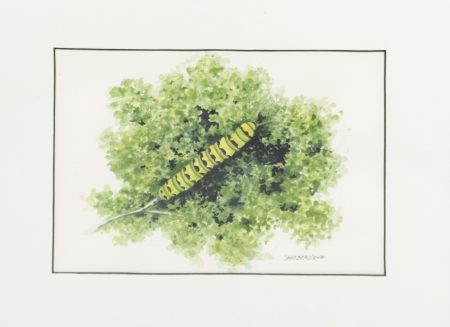Kennedy Heights Art Center’s holiday exhibition is “Metamorphosis.” Featuring artists from the Kennedy Artist Collective, Mallory Feltz, director of exhibitions and public art, explains that the show’s title, was chosen
because of its meaning of change–either personally, professionally, and/or artistically. This year has brought about a lot of change for many of us, and some of that is reflected in the works. It is also a title that allows for some open interpretation, while still focusing on a theme of growth.

The Collective is open to “all manner of artists–visual artists, musicians, dancers, performers, writers, designers, etc.” Just fill out a simple application, pay the $50 annual dues, and volunteer for 12 hours annually and you’re in. The Center mounts an annual exhibition to give these artists impetus “to keep creating and pushing one’s creativity with the goal (and opportunity) to show new work.”
The only things that hold the group together are the desire to make art and to build community. This guarantees that artists working in variety of mediums, styles, and levels of accomplishment are included. It also effectively means there is something for everyone.
Let me use two quite different approaches to the same subject–pelicans-to illustrate that: Sue Wilke’s When Fog Lifts, a photograph, and Michael Hensley’s acrylic-on-canvas Pink-Backed Pelican.

Sue Wilke, a retired corporate and nonprofit executive, has morphed into an accomplished photographer. When Fog Lifts features two pelicans balancing on pylons of a derelict pier; they hold the frontal plane while in the distance, a boat establishes the horizon line. A bit of the Florida shoreline juts out and is veiled by fog, lending the black-and-white photograph a Turner-esque air. Wilke has recorded the scene with a large dollop of romanticism.
Michael Hensley takes a different approach and puts the pink-backed pelican at the center of his composition.

After 40 years working in advertising, Hensley returned to his “artistic passion” when he picked up a paintbrush again in 2018.
The artist’s Pink-Backed Pelican glides on placid waters. The water fowl is made of smoothly brushed shapes; there’s no nuance here.
Per his artist statement on the wall label (the Art Center thoughtfully supplied wall labels with brief biographies and short artist statements), Hensley describes his artistic approach as making
…stylized use of bold fractile (sic)-like shapes to create images. Each shape in the painting is composed of a single color, together these flat color shapes create the depth, dimension, and flow I strive to achieve. In my compositions I look to accentuate the movement and flow I see, sometimes it elevates the main image and sometimes it obscures it but it always makes the image a little more interesting than reality.
That’s how Hensley understands his work. I won’t dispute it, but to me it looked more like the paint-by-numbers pieces that I liked enough to pick up at yard sales, flea markets, and junk (junque, if you prefer) stores (shoppes) to display on my walls.

Hensley’s pelican didn’t have much personality. That would never be said of June Pfaff Daley’s exuberant Pig Kabob, a brilliantly colored porcine visage with soulful eyes who is chomping on a delicious looking fruit kabob.
A self-described “freelance graphic designer, mixed-media artist, crafter, and art instructor,” Daley is “inspired by classic children’s stories, nursery rhymes, fictional characters, travel, yard sales, shopping, and even baking…My quirky sense of humor heavily favors all things whimsical.”
This affinity is on full display in Pig Kabob. In the Bahamas, a popular tourist activity is swimming with pigs, not elegant dolphins. Daley explains, “Tourists gleefully hold skewers out to these robust swimmers in hopes of capturing the perfect photo memory. The pigs meet their two-legged friends with delightful toleration.”
Moving from the silly to the sublime are Helen Haberstroh’s delicate renditions of nature. They reminded me of exquisite 18th-century botanical prints.

The pandemic forced the self-taught Haberstroh to forgo her usual subject matter–Portraits of Houses in ink-and-watercolor commissioned by homeowners–and to stay closer to home. She found “willing models” in her yard and garden.

In Pillar in Parsley, a “voraciously hungry caterpillar…feasted on a healthy parsley plant” outside her door. Haberstroh missed the dramatic metamorphosis from caterpillar to chrysalis to black swallow-tailed butterfly but it’s implied.

Haberstroh calls her drawings “flights of fantasy.” Let me indulge my own and anthropomorphize Michael Streff’s abandoned cars.
Trained in graphic design, Streff had a successful career in design, illustration, and display work and then freelanced for 40 years as a cartoonist and illustrator. He abandoned this when computers and photography took over. Leaving that behind, he “dabbled” in other interests including an antiques business, photography, and artwork for his own pleasure.
Streff’s stark black-and-white linocut CADDY AT REST shows a rundown vehicle, a Cadillac confirmed by the logo on the car’s hood, sitting on deflated tires underneath the overhang of a ramshackle gas station. Simply lettered signs advertising gasoline, oil, ice, tires, and the tourist cabins out back are tacked willy-nilly on the roughly built station. The auto’s headlights become eyes, four not two, and its grill looks like a mouthful of teeth in dire need of orthodonture.
The scene could illustrate a Southern Gothic yarn where the car becomes sentient and takes itself out for a spin at midnight. Calling Stephen King.

Connie Springer, who studied with Ken Landon Buck at the Art Academy of Cincinnati, describes herself as “a watercolor artist with a penchant for storytelling.” She’s sketched out a tale in Billiards in Berlin, but doesn’t give us much in the Hopper-like scene; she’s left us to puzzle it out.
Two billiard tables are set at right angles and are lit by rectangular hanging lamps that echo the shape of the green baize table. As abstract shapes, they balance the expanse of the rust-red floor. The players are blurred, their features indistinct. They have pulled back their pool cues, readying themselves to take the shot.
On the long side of a table, a man in a short-sleeved shirt with the beginnings of a paunch looks out the window, more interested in what is going on in the street than the action in the billiard parlor. The mullions of the possibly floor-to-ceiling windows divide the glass in the same proportions as the tables as do the blank windows of the building across the way. Titles do not always affect how you see an artwork but here the mention of Berlin is potent. I think my reaction to Springer’s moody watercolor would have been rather different if the pool hall were in Oshkosh.
Most of the works on view are interpretations of reality, but there are a few abstractions.

The Collective artists generally use fine art mediums, but there is no prejudice against those who use traditional craft materials for their art.

“Metamorphosis” is a hodgepodge of mediums, styles, skill levels, education, ages. In other words, there is something for everyone.
–Karen S. Chambers
“Metamorphosis,” Kennedy Heights Art Center, 6546 Montgomery Rd., Cincinnati, OH 45213; 513-631-4278, kennedyarts.org. Wed.-Fri. 10 am-5 pm; Sat. 11 am-4 pm. Through Dec. 23.